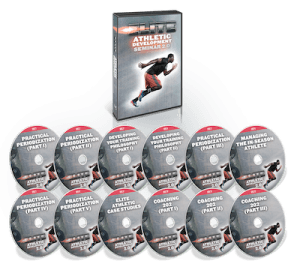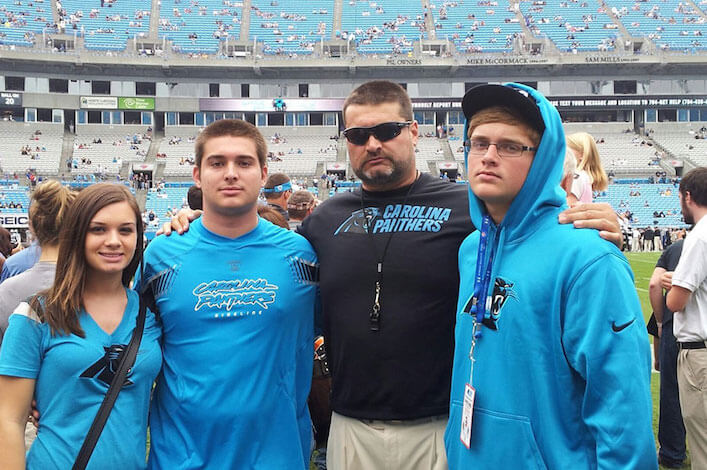I never have, and never will, claim to be a perfect coach.
Like most of us, the deeper I dig, the more I realize I really don’t know.
But one thing I feel helps keep me at the top of my game is surrounding myself with other great coaches.
I know that if I spend time around other people who are serious about getting better, then almost by default, I’ll get better as well.
Joe Kenn is a guy I’ve learned a ton from over the last couple of years. This guy is constantly thinking about, manipulating, and evolving his programs to get the most out of his athletes.
And to be frank, if I didn’t learn a thing or two from Joe, then you should really worry about me!
 In this post I’m going to cover four ways Joe has made me a better coach. I’m sure there are plenty of other things that I’ve already forgotten, but this should be a good start.
In this post I’m going to cover four ways Joe has made me a better coach. I’m sure there are plenty of other things that I’ve already forgotten, but this should be a good start.
(And just as an aside, I’m not going to pull any punches here – Joe and I are selling our Elite Athletic Development 2.0 Seminar DVD’s this week for $100 off, so if you want to pick up a copy, I think it will absolutely make you a better coach. And if not, no worries at all – I hope you enjoy the content!)
1. Introducing me to The Rejuvenation Block
When athletes come to me in the off-season, it’s all about preparing them for the upcoming season.
Sometimes that’s a focus on speed and power development.
Other times it’s about strength.
And of course, there are a ton that need to work on their conditoining as well.
But one thing that I had never done in the past was what Coach Kenn calls a “Rejuvenation” block. In this phase, the goal is quite simply to knock the cobwebs off the body and get the athlete moving and shaking well again.
In the past, I had typically used the first week or two as a “ramp up” phase for the entire off-season program. And there are still times with athletes that I still have to do this (especially if their off-season is very short).
However, if I have the time I love running a Rejuvenation block first and foremost. This may only be a week or two, but you can get a ton done including:
- Resetting the system and getting to a more “neutral” state,
- Restore base levels of mobility and movement capacity,
- Start to rebuild work capacity, and
- Introduce training in a low-intensity, low stress environment.
If you have the time to really slow cook your athletes in the off-season, give the Rejuvenation block a shot. I guarantee you, and your athletes, will love it!
2. Reminding Me About The Performance Microcycle
When it comes to standard mesocycle blocks, there are two standard variations that you see quite frequently:
- An ascending block, where you start with what amounts to a “deload” week and build up either volume or intensity over the next three weeks of the training block, or
- A descending block, where you start high in Week 1, build volume or intensity over the next three weeks, and then finish with a deload week.
Before the EADS 2.0 seminar last year, I was dabbling with both to see if I liked one or the other better. I think there’s a time and a place for each, but this dabbling had also caused me to get away from my favorite mesocycle layout.
While both of the above options are good for lower level clients/athletes, your higher end athletes will respond incredibly well to what Joe calls a “performance microcycle.” A performance microcycle looks like this:
- Week 1 – Base Week
- Week 2 – Intensification Week
- Week 3 – Deload (to Reload)
- Week 4 – Performance Week
By deloading in the third week, you allow yourself (or your athletes) to super-compensate and then express the strength or power that you’ve accumulated over the course of the training block!
(Side note: If you’ve ever read my Modified 5×5 Squat article, I used this exact progression – I just didn’t have the cool name!)
While I may stray from it from time to time going forward, the performance microcycle will definitely be a staple in my programs going forward.
3. Convincing Me to Train Power Late in the Session
If you’ve ever read a textbook on athletic development, they’ll tell you that you have to train power first, strength second, and conditioning last.
And as a broad rule of thumb, that’s not necessarily incorrect – especially if your goal is to improve top-end power development.
However, anyone that trains athletes also knows that you have to be able to express speed or power not only when you’re fresh, but (perhaps more important) when you’re fatigued as well!
Before we met years ago, I was very locked into this rigid mentality as well. But when he made this point, I feel like it really allowed me to open up my programming and make it better for athletes.
Nowadays, we may absolutely lead with our R4 Reactive work (which will mostly consist of runs, jumps and throws based on the athlete and their position), but then we will absolutely finish with various types of power work at the end of the session as well.
Early on in a program it may be more controlled means that are simply there to generate a blend of power with the necessary energy system demands (Prowler, dead treads, sled sprints, etc.).
But as we get closer and closer to the competitive season, we’ll spend more time merging the worlds of sport-specific movement with sport-specific energy system demands.
4. Validating my love for 2-KB front squats
For the last 2-3 years, I’ve made no bones about my love for 2-KB front squats.
This variation of the lift does a ton of good things for us:
- Strengthens the quads to a high degree,
- Strengthen the anterior core, and
- Is incredibly easy to teach and coach.
But like anything in life, sometimes it helps to get a little back-up, or validation, that you’re on the right track with things.
Coach Kenn and I were discussing this lift years ago, and he’s mentioned numerous times that this is now one of his go-to lower body lifts for athletes as well.
I would say regardless of your end goal (strength, physique, athletic dominance, etc.), 2-KB front squats are an awesome exercise that you should be using from time-to-time in your programming.
Whether it’s simply to maintain structural balance or movement quality, or even as a primary lift, they are a fantastic exercise that give maximal benefit with minimal downside.
Summary
While none of us will ever become the “perfect coach,” I think we should all make it a goal to reassess and reevaluate how we do things in our respective systems.
Whether it’s programming, coaching, assessments, or anything in between, all of us can stand to get better.
Keep learning my friends and enjoy the process!
All the best
MR
P.S. – Don’t forget – you have until Friday night at midnight, EST, to save $100 on the Elite Athletic Development 2.0 Seminar DVD’s. Pick up your copy today!

